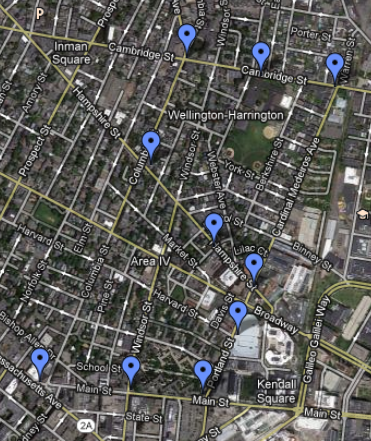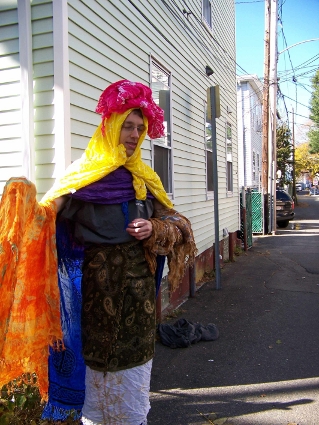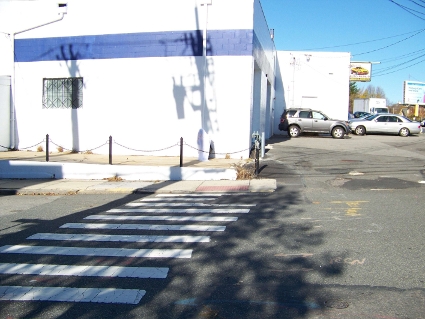Cambridge Waldo
Cambridge Waldo puzzle from the 2013 MIT Mystery Hunt was supposed to be easy. Its goal was to get people out of the building for some fresh air. I made this puzzle jointly with Ben Buchwald, Adam (Pesto) Hesterberg, Yuri Lin, Eric Mannes and Casey McNamara. The puzzle consists of 50 pictures of different locations in Cambridge; one of the above individuals was hiding in each picture. Let me use this opportunity to thank my friends for starring in my puzzle and being inventive while doing it.
The puzzle starts with a group picture of my stars. The caption to the picture gives their names. The fact that they are standing in alphabetical order is a clue.
Out of the 50 pictures, each person appears in exactly ten pictures. If you mark the locations of one person on a map, they look like a letter. For example, below are Ben’s locations that form a letter “S”. When you put the letters in the alphabetical order by people names you get the answer to the puzzle: SCAMP.

As you can see, you do not need all ten locations to recognize the letter. You might be able to recognize the letter with five locations, or at least significantly reduce possibilities for the letter. Besides, you do not need all the letters to recognize the answer. We thought that this was an easy puzzle.
And, to make it even easier, the order in which we posted the pictures was not completely random. The pictures of one person were in the order one might walk from one location to another. This played two important roles. If you recognize the person but do not recognize the location on the picture, you can make an approximate estimation of the location because it must be on the path between the previous and next locations. If you recognize the location but not the person, you can guess the person by checking whose path it fits better.
It was difficult to hide people, especially when there were no other people around. So we sometimes used props. We only used one prop per person. Here you can see Pesto with his sarongs in plain view. In the other picture (below) he is hiding under a white sarong. Yuri had a bicycle helmet. In one of the pictures, she hid so well that you couldn’t see her — but you could see her helmet. Ben had a bear hat. In one of the pictures you can only see a shadow of a person, but this person was clearly wearing a hat with bear ears. Eric didn’t have a prop, but my car was eager to make a cameo appearance at the Mystery Hunt, so I hid him in my car in one of the pictures.


As you might guess I made the pictures of different people at different times. So Ben Buchwald was the one who realized that solvers might differentiate people by looking at the data of the picture files. He carefully removed the original time stamps.
Despite our best intentions, our test-solvers decided not to leave their comfy chairs, but rather to use Google-StreetView. We strategically made some of the pictures not Google-StreetViewable, but our test-solvers still didn’t leave the comfort of their chairs. They just became more inventive. I do not know all the things they did to solve the puzzle, but I heard about the following methods:
- Finding a website with parking meter locations by meter number.
- Looking for one-way streets in the proper configuration to find likely places for One-Way/Do-Not-Enter signs.
- Looking up the street cleaning signs in the street cleaning schedule.
- Differentiating the streets by their separator line: double, single, or no line.
I have yet to understand why this puzzle was difficult for the Mystery Hunt teams.
Share:
Alex Power:
As a point of data from test-solving My Summer Vacation for last year’s hunt – we had the same issue where the intention was for people to get on the T and find things in the stations, the test-solvers solved it without getting on the subway, and almost nobody solved it during the hunt. I think the moral is that people tend to avoid puzzles that involve going outside.
(also, the puzzle looks like you have to lived in Cambridge for a while to even start to solve it, which eliminates a fair portion of people)
13 February 2013, 5:33 pmTanya Khovanova:
Alex,
Yes I was hoping that MIT people would just recognize most of the places.
13 February 2013, 6:00 pmDan Katz:
Two possible reasons teams found this difficult:
1) I spent four years at MIT, and I certainly don’t have all of Cambridge visually memorized. I think you’re overestimating how much time MIT students spend exploring Cambridge, since most points of interest are clustered closely around T stations
2) 50 locations, even if you know the area fairly well, are going to take a very long time to plot on a map, and even longer if you attempt to locate them on foot as you suggest. During Mystery Hunt, people are looking at many puzzles, not just one. I think this was an issue with many of the puzzles in this year’s Hunt; even if you knew what you were doing, the volume of data involved was difficult to process in a reasonable amount of time. Combining this with the number of puzzles made many of them unfeasible, even for a very large team like mine.
I realize test-solvers successfully solved this puzzle, but I would be curious (just as a data point) to know how many solvers it took and how much time they spent on it.
28 February 2013, 10:39 amTanya Khovanova:
Dan, three people worked on it. I do not know about the time.
28 February 2013, 11:05 am